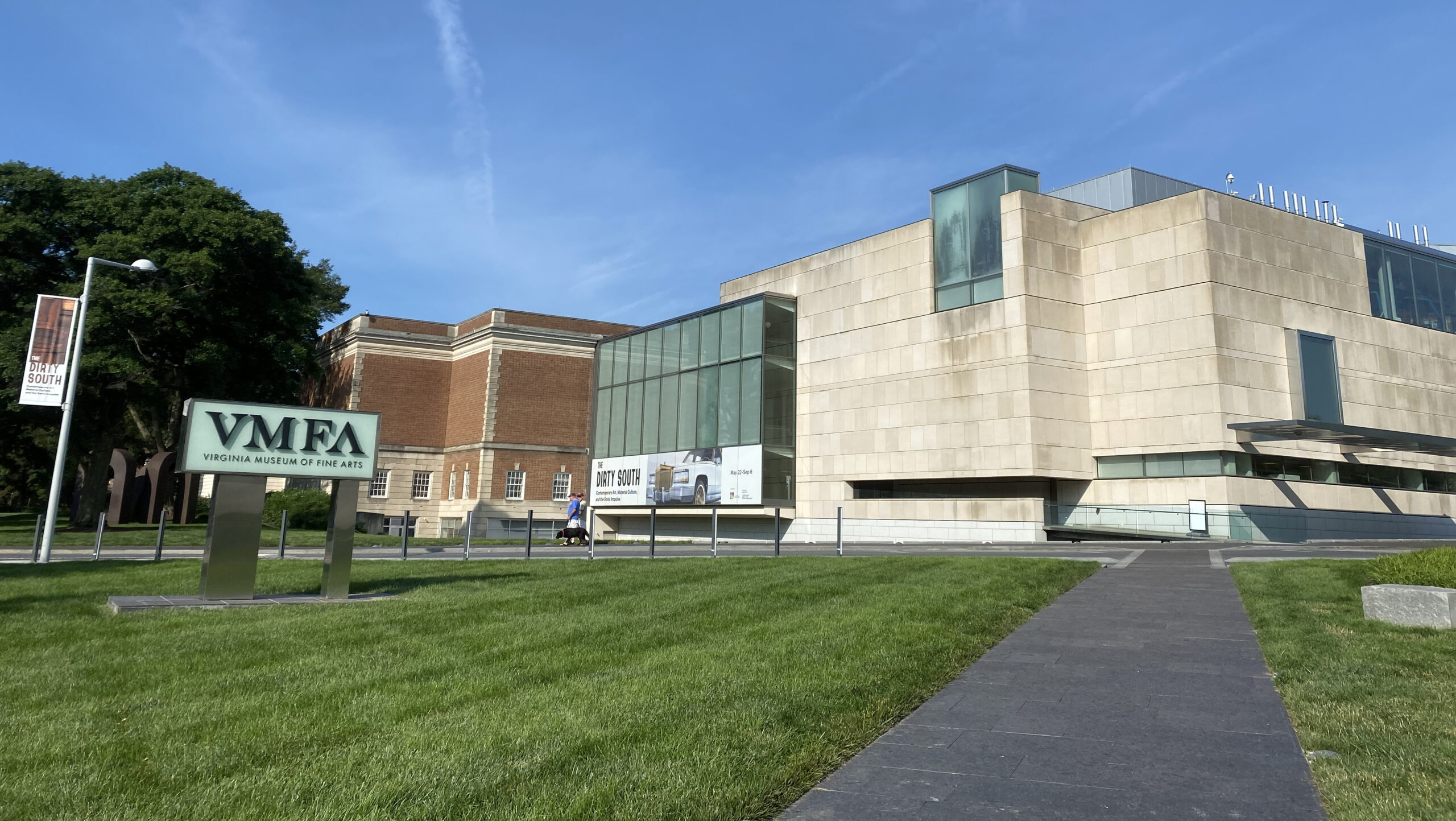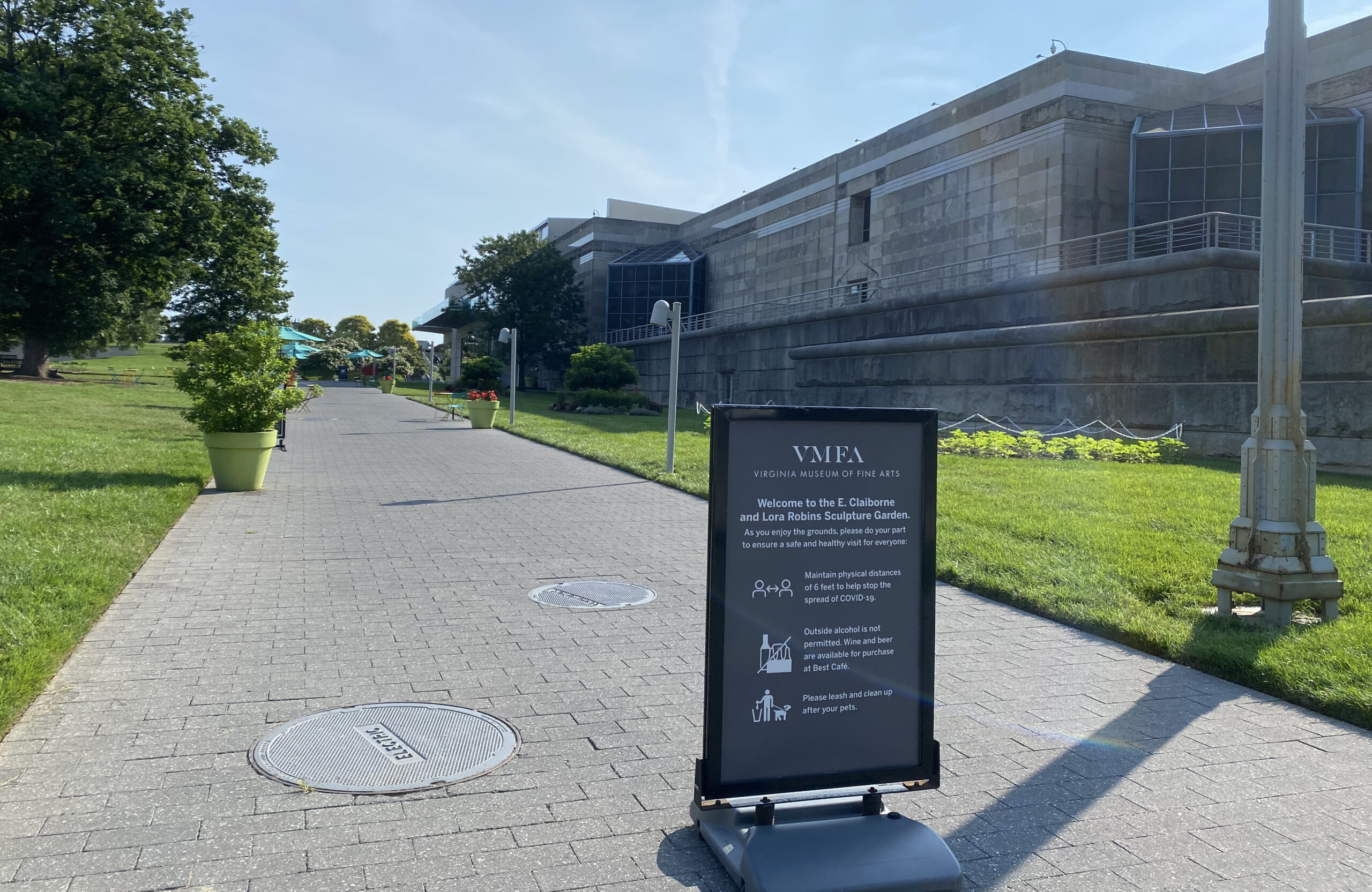
The Virginia Museum of Fine Arts will unveil its choice of architect of a massive new expansion later this month. (Photos courtesy of VMFA)
Correction: An earlier version of this story incorrectly reported that VMFA would be unveiling the design of its planned expansion later this month. It will only be announcing the architect of the project. The museum also recently created and hired a photography curator.
Whittled down from dozens of proposals after an RFP last year, the Virginia Museum of Fine Arts expects to make public later this month its chosen architect for a massive new expansion.
The state-owned museum said this week it will announce the winning architectural proposal by June 30 for a $190 million project that would increase its space from 650,000 square feet to nearly 800,000 square feet.
VMFA in December put out a call for proposals for the design of three phased components: A new 100,000-square-foot wing off of the existing Mellon and Lewis Wing; a renovation of 45,000 square feet in the museum’s 1936, 1954 and 1970-built buildings; and a new freestanding annex building in the southwest corner of the VMFA campus that will house a new collection center.
Museum Director Alex Nyerges said the expansion has been in the works for 11 years.
“When we opened the McGlothlin Wing on May 1, 2010, we had already outgrown that facility in terms of exhibition space, collections space, conservation space and special exhibition space,” Nyerges said. “With all of those needs being pressed, we began planning early on to look at expansion.”
He added, “It’s $190 million of capital expenditures between new construction and renovation. That makes it larger than the cost of the McGlothlin expansion, which was about $150 million.”
Nyerges said that the first phase will likely be the renovation of the Cheek Theater to widen the stage to broaden its use for performing arts such as ballet. The design phase of that part of the project is expected to start in July. Plans also call for renovating the theater’s green rooms and dressing rooms.
The largest piece of the expansion is a planned five-story addition of 100,000-125,000 square feet to be built onto the Mellon and Lewis Wing, which was constructed in 1985. It will house an entertainment space for people to sit and be served food and drinks and will also open up into the VMFA garden.
“Imagine our Friday evening events that we will be resuming — hopefully, this fall after the pandemic has subsided — having some indoor space spilling into the garden, which is one of the most popular ways to spend a Friday evening in Richmond,” Nyerges said.
Above this five-story addition will be about 11,000-12,000 square feet of new exhibition space for major special exhibitions like the Terracotta Army exhibition or the current Dirty South exhibition.
The new collection center will have about 40,000 square feet for conservation and storage for permanent collections.
“We’ll be tripling the amount of conservation space, adding more conservators and adding more disciplines,” Nyerges said. “We’re adding photography to our paper specialty and we have object painting and paper. We’re going to create a sub-specialty in the paper conservation department for photography.”
A new a curator of photography position was recently appointed and will begin work at the museum in September.

The VMFA expansion will include a new 100,000-square-foot wing off of the existing Mellon and Lewis Wing, a renovation of 45,000 square feet in three museum buildings; and a new annex building.
About 200 new parking spaces also will be added as part of the expansion on the south end of the campus.
“We have 600 spaces in our parking deck currently, but when we do big exhibitions it’s clearly insufficient,” Nyerges said.
Nyerges said the museum’s expansion plan was first approved by the state in 2019. It then had to raise $6.3 million in preliminary planning money. In 2020, the General Assembly approved an appropriation of $112 million from the Virginia Public Building Authority for the museum.
Since December, VMFA has been weeding through 30 proposals from architects all over the world. It then picked five finalists before settling on the final choice, which as of last week was at the attorney general’s office for a final review.
The chosen architect will be handling all three parts of the project. The design and planning stage is expected to finish by June 2023, and the construction of the three concurrent projects will likely take another 24 months, Nyerges said.
The museum will handle finding construction companies with the help of the chosen architect.
Part of the selection process for the architect, Nyerges said, was how they would handle construction and keep the multi-pronged project moving forward.
“To make any expansion or renovation successful, you need to have a team in lockstep,” he said. “It’s very likely that we will begin looking at and interviewing construction companies very early on. It will save us time in the long run by only aiding the architectural process, but also it will allow us to achieve the two most important goals we have for the project itself: (being) on time and on budget.”

The Virginia Museum of Fine Arts will unveil its choice of architect of a massive new expansion later this month. (Photos courtesy of VMFA)
Correction: An earlier version of this story incorrectly reported that VMFA would be unveiling the design of its planned expansion later this month. It will only be announcing the architect of the project. The museum also recently created and hired a photography curator.
Whittled down from dozens of proposals after an RFP last year, the Virginia Museum of Fine Arts expects to make public later this month its chosen architect for a massive new expansion.
The state-owned museum said this week it will announce the winning architectural proposal by June 30 for a $190 million project that would increase its space from 650,000 square feet to nearly 800,000 square feet.
VMFA in December put out a call for proposals for the design of three phased components: A new 100,000-square-foot wing off of the existing Mellon and Lewis Wing; a renovation of 45,000 square feet in the museum’s 1936, 1954 and 1970-built buildings; and a new freestanding annex building in the southwest corner of the VMFA campus that will house a new collection center.
Museum Director Alex Nyerges said the expansion has been in the works for 11 years.
“When we opened the McGlothlin Wing on May 1, 2010, we had already outgrown that facility in terms of exhibition space, collections space, conservation space and special exhibition space,” Nyerges said. “With all of those needs being pressed, we began planning early on to look at expansion.”
He added, “It’s $190 million of capital expenditures between new construction and renovation. That makes it larger than the cost of the McGlothlin expansion, which was about $150 million.”
Nyerges said that the first phase will likely be the renovation of the Cheek Theater to widen the stage to broaden its use for performing arts such as ballet. The design phase of that part of the project is expected to start in July. Plans also call for renovating the theater’s green rooms and dressing rooms.
The largest piece of the expansion is a planned five-story addition of 100,000-125,000 square feet to be built onto the Mellon and Lewis Wing, which was constructed in 1985. It will house an entertainment space for people to sit and be served food and drinks and will also open up into the VMFA garden.
“Imagine our Friday evening events that we will be resuming — hopefully, this fall after the pandemic has subsided — having some indoor space spilling into the garden, which is one of the most popular ways to spend a Friday evening in Richmond,” Nyerges said.
Above this five-story addition will be about 11,000-12,000 square feet of new exhibition space for major special exhibitions like the Terracotta Army exhibition or the current Dirty South exhibition.
The new collection center will have about 40,000 square feet for conservation and storage for permanent collections.
“We’ll be tripling the amount of conservation space, adding more conservators and adding more disciplines,” Nyerges said. “We’re adding photography to our paper specialty and we have object painting and paper. We’re going to create a sub-specialty in the paper conservation department for photography.”
A new a curator of photography position was recently appointed and will begin work at the museum in September.

The VMFA expansion will include a new 100,000-square-foot wing off of the existing Mellon and Lewis Wing, a renovation of 45,000 square feet in three museum buildings; and a new annex building.
About 200 new parking spaces also will be added as part of the expansion on the south end of the campus.
“We have 600 spaces in our parking deck currently, but when we do big exhibitions it’s clearly insufficient,” Nyerges said.
Nyerges said the museum’s expansion plan was first approved by the state in 2019. It then had to raise $6.3 million in preliminary planning money. In 2020, the General Assembly approved an appropriation of $112 million from the Virginia Public Building Authority for the museum.
Since December, VMFA has been weeding through 30 proposals from architects all over the world. It then picked five finalists before settling on the final choice, which as of last week was at the attorney general’s office for a final review.
The chosen architect will be handling all three parts of the project. The design and planning stage is expected to finish by June 2023, and the construction of the three concurrent projects will likely take another 24 months, Nyerges said.
The museum will handle finding construction companies with the help of the chosen architect.
Part of the selection process for the architect, Nyerges said, was how they would handle construction and keep the multi-pronged project moving forward.
“To make any expansion or renovation successful, you need to have a team in lockstep,” he said. “It’s very likely that we will begin looking at and interviewing construction companies very early on. It will save us time in the long run by only aiding the architectural process, but also it will allow us to achieve the two most important goals we have for the project itself: (being) on time and on budget.”

This is fantastic news! This round of expansion will further enhance the VMFA as one of the true gemstones in Richmond’s bejeweled crown of attractions.
This is great. I only hope the architecture will be good, and not too trendy
The VMFA is a wonderful institution that does a lot for Richmond. I’m disappointed, though, to hear that they plan to pave over what is now green space to create parking to accommodate openings that happen once every few months. Could they not make an arrangement with the VA Museum of History and Culture (which just took down a bunch of old Magnolias to create more parking) to share parking on those occasions, or with Saint Benedict, which also has a large lot that would likely be empty at those times?
The article doesn’t say the parking will be a surface lot. I would bet it will be underground and part of the building addition.